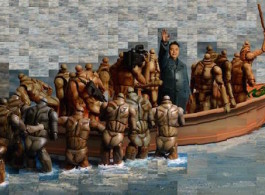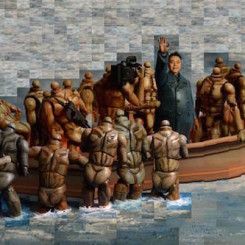Artist’s Reception Thursday, 20 August 2015, 6 to 8pm
Exhibition Period 20 August – 12 September 2015
Curatorial Statement
Silent Witness: Chow Chun Fai’s I Have Nothing to Say
Valerie C. Doran
Hanart TZ Gallery is pleased to announce Chow Chun Fai’s new solo exhibition I Have
Nothing To Say, which opens on 20 August 2015, from 6-8pm.
In I Have Nothing to Say, Chow Chun Fai adds a sardonic chapter to his lively, ongoing chronicle of contemporary Hong Kong realities—both virtual and actual. Chow is known for his evocative ‘film paintings’ and photo montage ‘representations’, revealing through his incisive but playful gaze certain pertinent messages for our time contained within popular Hong Kong film narratives on the one hand and the classical canons of art history on the other. In his new exhibition, Chow extends his gaze to include the virtual worlds of WhatsApp, Facebook and WeChat, adding quirky sketches of actual screen captures from his mobile phone to his chronicle.
Many of Chow’s works examine what one might term the morphology of Hong Kong identity—as it was in the past, as it is changing in the present, and the projected uncertainty of its future. In his celebrated film paintings, Chow depicts scenes from popular Hong Kong films (complete with the original bilingual subtitles) and renders them in moody canvases whose casually energetic brushwork camouflages the careful consideration that goes into each work. Chow researches meticulously, choosing scenes and dialogue that both point to and signify a critical psychological moment in his personal existence as well as in the unfolding reality of the time and place in which he lives—in other words, of Hong Kong itself. As of 2015, the Hong Kong landscape (both literal and metaphorical) has undergone radical challenges on many levels and navigated rough storms of conflicting narratives and whole new levels of fabrication and deception—from phone scams and fake eggs to deceitful politicians and fabricated news.
Under such tumultuous conditions, it is less a question of standing firm and reflecting on Hong Kong identity, as of having no firm ground to stand on at all. In one of the key paintings in I Have Nothing to Say, the artist telescopes back in time and picks out a scene from Fruit Chan’s film Little Cheung (2000), set in 1997. Executed in a gentle, luminous palette, the painting depicts three children perched on a bicycle and looking out at the Victoria Harbour skyline on the eve of the Handover. The boy, Little Cheung, points out the Tamar site—at the time the headquarters of the British Army—and one of the little girls (who are both illegal immigrants from the Mainland), proudly says: ‘I know, it will belong to the People’s Liberation Army’.
In his Let the Bullets Fly painting series Chow chooses a darker, more brooding palette to recreate telling moments from Jiang Wen’s immensely popular 2010 film, a dark comedy set in the 1920s about corrupt politicians, warlords and bandits who switch identities back and forth and engage in endless games of double-cross. Chow’s Captured from my mobile phone series enhances the sense of fabrication and deception, especially as the absurd Internet postings Chow depicts were originally disseminated as ‘real news’: A mainland newspaper claims that robots from a Star Wars film are actually military cyborgs used to protect the South China Sea, while North Korean media announces they have landed a man on the sun, and a young man in Anhui province has cosmetic surgery to turn his face into that of his ‘idol’ Lei Feng—a fabrication of a (Cultural Revolution) fabrication. Following along this trajectory are Chow’s performative, photographic, mixed-media installations KIM Jong-un on Boat and Last Judgement Michelangelo’s Boat. Chow here projects himself into a famous North Korean propaganda poster, impersonating the Supreme Leader himself. Expanding on the theme of crossed identities, the companion installation reconstructs a section of Michelangelo’s mythical masterpiece from the same props as those used for Kim’s.
In I Have Nothing to Say, it is the ‘ungrounded’ state of living amidst fabrications, absurdities and untruths that Chow is exposing, and to which he is (silently) bearing witness. To borrow a phrase, Chow Chun Fai has nothing to say, and he is saying it.
Artist’s Statement
‘I Have Nothing To Say’
When I say ‘I have nothing to say’, it’s for one of three reasons: either because of my intense frustration with the way things are, or because I have to use metaphors or fables to stand in for the things I’m unable to talk about directly, or because I find that it’s only by taking a more distant, oblique approach that I can accurately portray the things I see happening in front of me.
This exhibition can be divided into three sections:
The first is comprised of images I have captured from my mobile phone of postings from electronic media/ social platforms such as Facebook, WhatsApp and WeChat. Some of these postings are from actual newspaper articles or other media reports, others are clearly political propaganda: but what they all have in common is that they are either deceptive information or outright lies, of the kind we encounter on a daily basis. From the huge amount of data I collected, I have made a selection of 49 of these capture images and turned them into drawings on paper.
The second section can be described as a new installment of my ‘film paintings’ series. This time, however, I selected specific scenes and dialogue from films such as Jiang Wen’s Let the Bullets Fly, which are full of ambiguity and leave the audience constantly guessing what the real truth of the situation is. Each of these scenarios has a kind of symbolic significance related to our current socio-political situation—and once again, the main theme is about lies and deception.
For the third section of the exhibition, I have created a performative mixed-media work using appropriated images of the North Korean leader Kim Jong-un. In these images, which North Korea has broadcast to the world, Kim is shown surrounded by his devoted followers, many of whom reach out towards their idol with passionate, energetic gestures and with their faces contorted with emotion and even streaming with tears. To me these propagandistic images of Kim have the constructed pathos of Renaissance-period religious paintings, and it is this quality that I want to capture in this work.
Chow Chun Fai August 2015
Artist Biography
CHOW Chun Fai (b. 1980)
Born and raised in Hong Kong, Chow Chun Fai is known for his conceptually fuelled paintings and photographic installations. Chow holds a BA and MFA from the Fine Arts Department of the Chinese University of Hong Kong. He takes an activist role as an artist: Chow serves as Chairman of the Fotanian Artist Village and in 2012 he ran in the Hong Kong Legislative Council elections, for the Sports, Performing Arts, Culture and Publication constituency. Although his election bid was unsuccessful, it drew wide attention to grassroots issues related to art and culture in Hong Kong. Most recently his work has been featured in the exhibitions Venice Meeting Point at the Arsenale, Venice Biennale 2015; The Past Continuing at the Hong Kong Heritage Museum (2015); Hong Kong Eye at the Saatchi Gallery, London and the Liverpool Biennial (both UK, 2012). Chow is a recipient of the Grand Prize of the Hong Kong Arts Centre 30th Anniversary Awards, and the Sovereign Asian Art Prize.








